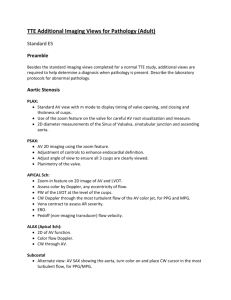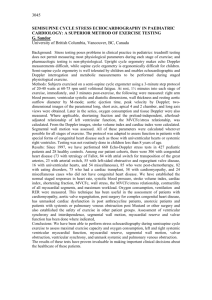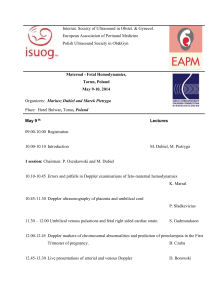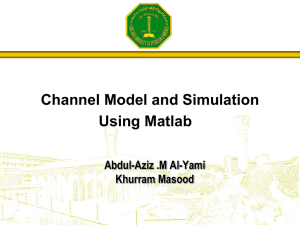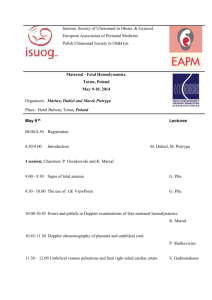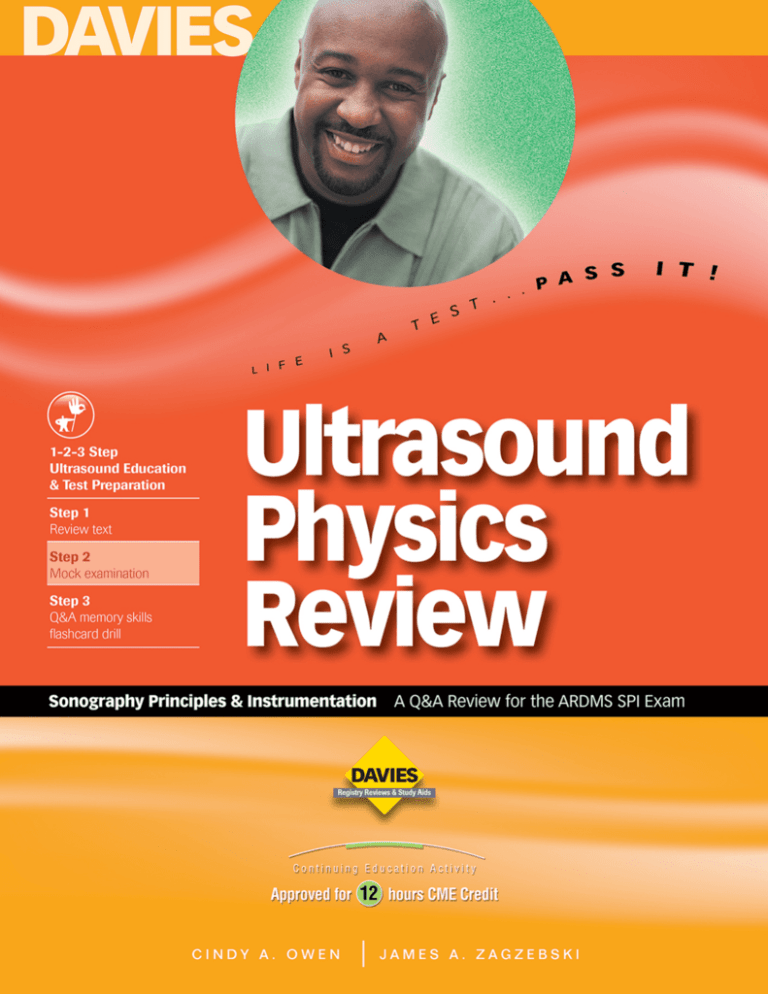
Mock Exam_Physics SPI Bk Cvr:Layout 1 10/21/09 9:31 PM Page 1
Looking for guidance and a clear understanding of the principles and facts on which you
will be tested? Here is the new SPI edition of the single bestselling mock exam devoted
to the ARDMS exam in ultrasound physics. Written by an internationally renowned sonographer who not only loves ultrasound physics but delights in—and excels at—explaining
it to others, Ultrasound Physics Review hones your test-taking skills, measures your
progress as you study, and reveals your strengths and weaknesses topic by topic.
Contains 600 complex registry-style questions that cover and follow the new ARDMS
Sonography Principles and Instrumentation (SPI) outline, 65 image-based questions, and
simple, clear explanations with current references for further study. Coverage includes
patient care, safety, and communication, physical principles, ultrasound transducers,
pulse-echo instrumentation, Doppler instrumentation and hemodynamics, and quality
assurance/quality control of equipment—all in the same proportion as in the exam itself.
Especially effective in combination with the Davies specialty exam reviews in Vascular,
Abdomen, Ob/Gyn, Adult Echo, Fetal Echo, and Breast. Why are our mock exams so popular and effective? Because they contain the same kinds of thought-provoking questions
you will find on the exam! 12 hours’ SDMS-approved CME. Davies catalog #11030.
About the authors . . .
Cindy Owen, RT, RVT, RDMS, FSDMS, is the author of Abdominal
Sonography Review, ScoreCards for Vascular Technology, Ultrasound Physics
Review, and the related CD-ROM Mock Exams. A former ARDMS and ICAVL
board member, she is Global Manager of Luminary & Research Programs at
GE Healthcare and lectures widely throughout the world. Cindy lives with her
family in Memphis.
James A. Zagzebski, PhD, is Professor and Chair of the Department of Medical
Physics at the University of Wisconsin, Madison, and the author of Essentials of
Ultrasound Physics. In addition to his teaching, research, and writing, Dr.
Zagzebski has lectured widely over the years, helping thousands of registry
candidates pass their physics exam.
The New CD-ROM Mock Exams from Davies are the most effective and
featuresome CDs available. Interactive, fun, and packed with regularly updated peer-reviewed content for SPI, Abdomen, Vascular, Ob/Gyn, Breast, and Fetal Echo. Work in Test Mode or Study &
Learn Mode and easily customize your Test and Study sessions to focus on specific exam topics.
Hundreds of continuously variable questions and images in registry format
sharpen your wits and ensure your knowledge of underlying principles and facts. Clear,
simple explanations and current references illuminate answers. Expert tutorials cover key
concepts in depth. Additional explanatory images and illustrations further clarify answers,
anatomy, and pathology. Test timer keeps you on track. Instant results analysis scores
and guides you topic by topic. Automatically review missed questions with one click.
Available CME credit. A snap to use. Bonus feature: Contact directory of key
organizations and societies, including ARDMS, SDMS, ARRT, CCI, ACR, and SVU.
Order toll-free 1-877-792-0005 or download from our website.
ISBN 0-941022-74-9
www.DaviesPublishing.com
DAVIES
Ultrasound Physics Review: SPI Edition
ii
Ultrasound Physics Review
A Q&A REVIEW FOR THE ARDMS SPI EXAM
2016
Cindy A. Owen, RT, RVT, RDMS, FSDMS
Director, Clinical Insights and Development
GE Healthcare, Point of Care Ultrasound
James A. Zagzebski, PhD
Professor Emeritus
Department of Medical Physics
University of Wisconsin
Editor in Chief
Ultrasound Physics Review | SPI Edition
iii
v
Copyright © 2016, 2015, 2014, 2013, 2012, 2011, 2010, 2009 by Davies Publishing, Inc.
All rights reserved. No part of this work may be reproduced, stored in a retrieval system, or
transmitted in any form or by any means, electronic or mechanical, including photocopying,
scanning, and recording, without prior written permission from the publisher.
Davies Publishing, Inc.
32 South Raymond Avenue
Pasadena, California 91105-1961
Phone 626-792-3046
Facsimile 626-792-5308
Email info@daviespublishing.com
www.daviespublishing.com
Printed and bound in the United States of America
ISBN 0-941022-74-9
Library of Congress Cataloging-in-Publication Data
Owen, Cindy.
Ultrasound physics review : a review for the ARDMS SPI exam / Cindy A.
Owen ; James A. Zagzebski, editor in chief.
p. ; cm.
Includes bibliographical references.
ISBN 0-941022-74-9
1. Diagnostic ultrasonic imaging--Examinations, questions, etc. 2.
Ultrasonics--Examinations, questions, etc. 3. Medical physics--Examinations, questions,
etc. I. Zagzebski, James A. II. Title.
[DNLM: 1. Ultrasonography--Examination Questions. 2.
Ultrasonics--Examination Questions. 3.
Ultrasonography--instrumentation--Examination Questions. WN 18.2 O967u 2009]
RC78.7.U4O966 2009
616.07'543--dc22
2009024704
Ultrasound Physics Review | SPI Edition
iv
Preface
T
is a question/answer/reference review of ultrasound
physics for ARDMS candidates who plan to take the Sonography
Principles and Instrumentation (SPI) examination for one or more ARDMS
credentials. It is designed as an adjunct to your regular study and as a method to
help you determine your strengths and weaknesses so that you can study more
effectively.
HIS MOCK EXAM
Facts about this updated SPI Edition of Ultrasound Physics Review:
§
It covers the topics covered in the current ARDMS exam outline.
§
It focuses exclusively on the SPI exam to ensure thorough coverage of
even the smallest subtopic on the exam. (For the ARDMS specialty exams
in Vascular Technology, Abdomen, Ob/Gyn, Breast, Adult
Echocardiography, and Fetal Echocardiography, see our exam-specific
reviews and mock exams at www.DaviesPublishing.com.)
§
We refer to the last best ARDMS content outline as a guideline for
coverage. At the same time, we organize the content using a
comprehensive, subject-driven approach to ensure that all important
topics are fully addressed. The ARDMS exam outline provides a
generalized categorical overview together with very specific clinical tasks,
but it can miss key intermediate topics you must know to pass your exam.
Hence our hybrid approach gives you the best of both worlds.
§
Ultrasound Physics Review contains nearly 600 questions, many of which
are image-based or otherwise illustrated.
§
Explanations are clear and conveniently referenced for fact-checking and
further study.
§
The SPI exam includes the new Advanced Item Type (AIT) questions that
assess practical sonography instrumentation skills. These include SemiInteractive Console (SIC) questions. The material you need to know to
answer these AIT questions is in our SPI mock exam; there just isn’t a
virtual console. For instance, our review contains a question that has an
image of poor quality and asks you what to do in order to optimize it.
Perhaps the answer is, “Decrease gain.” If so, you choose that answer. On
the semi-interactive console you answer it by using your computer’s
Ultrasound Physics Review | SPI Edition
v
mouse to adjust the gain control, decreasing it to optimize the poor image
in the question. That’s the difference.
§
Each of these semi-interactive console questions is marked “AIT–SIC” to
help you locate SIC items. AIT–SIC questions constitute about 10% of the
110-question SIC exam, according to ARDMS’s website. AIT–SIC
questions constitute approximately 19% of Davies’ mock exam—more
than 100 questions.
§
The ARDMS exam outline and contact information for the ARDMS
appears in Part 8 at the end of the book.
Ultrasound Physics Review effectively simulates the content and the experience
of taking the exam. Current ARDMS standards call for approximately 110
multiple-choice questions to be answered during a two-hour period. That is, you
will have an average time of 1 minute to answer each question. Timing your
practice sessions according to the number of questions you need to finish will
help you prepare for the pressure experienced by ARDMS candidates taking the
SPI exam. It also helps to ensure that your practice scores accurately reflect your
strengths and weaknesses so that you study more efficiently and with greater
purpose in the limited time you can devote to preparation.
ARDMS test results are reported as a “scaled” score that ranges from a minimum
of 300 to a maximum of 700. A scaled score of 555 is the passing score (the
“passpoint” or “cutoff score” for all ARDMS examinations). The scaled score is
simply a conversion of the number of correct answers that also, in part, takes into
account the difficulty of a particular question. Google Angoff scoring method if
you want to learn more about scaled scoring. Suffice it to say that it helps to
ensure the fairness of the exams and that in the case of all ARDMS exams 555 is
the minimum passing score.
We include below and strongly recommend that you read Taking and Passing
Your Exam, by Don Ridgway, RVT, who offers useful tips and practical strategies
for taking and passing the ARDMS examinations.
Finally, you have not only our best wishes for success, but also our admiration
for taking this big and important step in your career.
Cindy Owen
Cindy Owen, RT, RVT, RDMS, FSDMS
Ultrasound Physics Review | SPI Edition
100
PART 5
Doppler Instrumentation and
Hemodynamics
Ability to acquire color flow image
Ability to acquire a Doppler spectral image
Ability to take measurements from the spectral waveform
Hemodynamics
451. What is the maximum velocity limit for a 3 MHz CW Doppler unit operating
at a depth of 4 cm?
A.
B.
C.
D.
E.
40 cm/s
200 cm/s
2.5 m/s
4 m/s
None of the above
452. You will see aliasing of the Doppler spectrum whenever the frequency shift
exceeds:
A.
B.
C.
D.
E.
Twice the pulse repetition frequency
Three times the pulse repetition frequency
One-third the pulse repetition frequency
One-half the pulse repetition frequency
One-fourth the pulse repetition frequency
453. You obtained this color Doppler image while performing hepatic
sonography. There is no color signal detected within the portal vein. What
can you do to improve sensitivity to slow flow? See also Color Plate 1.
Ultrasound Physics Review | SPI Edition
A.
B.
C.
D.
E.
101
Increase wall filter
Decrease packet size
Decrease color gain
Decrease pulse repetition frequency
Change color map
AIT–SIC item.
454. The packet size in color Doppler refers to the number of:
A.
B.
C.
D.
E.
Pulses per second
Sample volumes per scan line
Scan lines per unit area
Pulse/listen cycles per acoustic scan line
Pulses required to create one frame
455. Which of the following is present in this Doppler spectral waveform? See
also Color Plate 2.
A.
B.
C.
D.
E.
Spectral broadening
Narrow velocity range
Aliasing
Mirror imaging
Range ambiguity
456. While performing a Doppler study, you underestimated the measurement of
the Doppler angle of incidence. What error will result from this mistake?
A.
B.
C.
D.
E.
The frequency shift will be underestimated.
No Doppler frequency shift will be detected.
Mirror imaging of the Doppler spectrum will occur.
The velocity estimation will be inaccurate.
Aliasing of the Doppler spectrum will occur.
Ultrasound Physics Review | SPI Edition
102
The next three questions refer to the following illustration, in which
five transducers are imaging a vessel at different incident angles. The
arrow indicates the direction of blood flow.
457. Which transducer will detect the largest Doppler frequency shift?
A.
B.
C.
D.
E.
458. Which transducer would NOT detect a Doppler frequency shift?
A.
B.
C.
D.
E.
459. Which transducer would demonstrate a waveform ABOVE the zero
baseline?
A.
B.
C.
D.
E. All except for E
460. A commonly used process for determining direction in a Doppler instrument
is:
A. Zero-crossing detection
B. Autocorrelation
C. Phase quadrature detection
Ultrasound Physics Review | SPI Edition
103
D. Range gating
E. Spectral analysis
461. What method is used to steer the color beam with a linear array transducer?
A.
B.
C.
D.
E.
Mechanical
Electronic time delays
Electronic voltage variation
Apodization
The color beam cannot be steered with a linear array transducer.
462. When color Doppler is activated, in order to maintain frame rate, what may
be reduced in the underlying B-mode image?
A.
B.
C.
D.
E.
The number of focal zones
The scan line density
The frame averaging (persistence)
A and B
B and C
463. What Doppler technique does NOT provide range resolution?
A.
B.
C.
D.
E.
Color Doppler
Power Doppler
Pulsed-wave Doppler
Continuous-wave Doppler
No Doppler technique can provide range resolution.
464. You have obtained a color Doppler image of the common carotid artery. If
the received ultrasound frequency is greater than the transmitted ultrasound
frequency, which of the following would be correct?
A.
B.
C.
D.
E.
Color encoding red, negative Doppler shift
Color encoding blue, negative Doppler shift
Color encoding red, positive Doppler shift
Color encoding blue, positive Doppler shift
No Doppler shift was detected.
465. Aliasing is a potential problem in PW Doppler because of:
A.
B.
C.
D.
The use of high pulse repetition frequencies
The Doppler signal being sampled rather than recorded continuously
Dynamic focusing
The motion of the interface perpendicular to ultrasound wave
propagation
E. Perpendicular incidence
466. What does the Doppler signal spectral display depict?
Ultrasound Physics Review | SPI Edition
A.
B.
C.
D.
E.
104
Relative signal power at each frequency in the Doppler signal
Depth to each vessel
Volume flow rate
Transmit frequency
Acoustic power
467. Increasing the wall filter during Doppler sampling will:
A.
B.
C.
D.
E.
Increase visibility of low-velocity signals
Increase spectral broadening
Decrease bandwidth
Reduce display of low frequency shifts
Reduce aliasing
AIT–SIC item.
468. What would be the most likely result from increasing the transmit frequency
of the color Doppler?
A.
B.
C.
D.
E.
Improved sensitivity to slow flow
Improved penetration for imaging flow in deep tissues
Reduced flash artifact obscuring small vessel flow
Reduced color Doppler aliasing
Improved visibility of complex flow hemodynamics
AIT–SIC item.
469. What would be the most likely result from lowering the color threshold?
A.
B.
C.
D.
E.
Increased visibility of small vessel flow in a parenchymal organ
Decreased flash artifact
Increased color writing on the vessel or cardiac wall
Increased frame rate
Improved color penetration
AIT–SIC item.
470. What method is most commonly used to perform spectral analysis for
pulsed Doppler?
A.
B.
C.
D.
E.
Zero-crossing detection
Fourier analysis
Reynolds number
Cross correlation
Autocorrelation
471. During Doppler interrogation of the carotid artery, you detect spectral
mirroring. Which of the following is a common cause of this artifact?
A. Doppler angle of interrogation near 90°
B. Doppler angle of interrogation near 0°
Ultrasound Physics Review | SPI Edition
105
C. Wall filter set too high
D. PRF set too low
E. Doppler gain set too low
AIT–SIC item.
The next two questions refer to the following image:
472. This Doppler waveform can be most accurately described as exhibiting:
A.
B.
C.
D.
E.
Aliasing
Spectral broadening
Mirror-image artifact
Bidirectional flow
Saturation
473. What system control should be adjusted to optimize this waveform?
A.
B.
C.
D.
E.
Wall filter
Packet size
Gain
Pulse repetition frequency
Sample volume size
AIT–SIC item.
474. What Doppler control should be adjusted to optimize this Doppler spectral
waveform?
A.
B.
C.
D.
Wall filter
Packet size
Gain
Pulse repetition frequency
Ultrasound Physics Review | SPI Edition
106
E. Baseline
AIT–SIC item.
475. The Doppler frequency shift is defined as:
A. The difference between the Doppler frequency and the imaging
frequency
B. The difference between the transmitted and received frequencies
C. The time between the transmitted and received pulses
D. The rate at which the transducer emits pulses
E. The amplitude of the transmitted Doppler signal
476. According to the Doppler equation, which of the following is NOT true?
A. Increasing Doppler frequency will increase the frequency shift.
B. Increasing the Doppler interrogation angle will increase the frequency
shift.
C. Decreasing the reflector speed will decrease the frequency shift.
D. No frequency shift is detected when the Doppler beam strikes the
reflector with perpendicular incidence.
E. Velocity information can be obtained from the frequency shift if the angle
of incidence is known.
477. The Nyquist limit describes which of the following?
A. Penetration limit of pulsed-wave Doppler
B. Transit time of pulsed-wave Doppler
C. Sampling frequency needed for detecting the Doppler signal
unambiguously
D. Sampling method used for continuous-wave Doppler
E. Method used for determining directional information in a Doppler-shifted
signal
478. What information does the z-axis (brightness) on the Doppler spectrum
provide?
A.
B.
C.
D.
E.
Velocity
Velocity range
Bandwidth
Amplitude
Frequency shift
479. A waveform from the internal carotid artery obtained at a Doppler angle of
45° shows aliasing. Which of the following choices will help you unwrap this
waveform?
A. Decrease the angle of incidence.
B. Decrease the high pass filter.
Ultrasound Physics Review | SPI Edition
107
C. Raise the zero baseline.
D. Increase the pulse repetition frequency.
E. Increase the Doppler frequency.
480. While performing a color Doppler exam in the abdomen you have adjusted
several system controls and notice that the frame rate has decreased.
Which of the following adjustments can you make to improve the color
frame rate?
A.
B.
C.
D.
E.
Increase the packet size
Decrease the pulse repetition frequency
Decrease the color box width
Increase the scan line density
Increase the wall filter
481. You are performing a carotid duplex examination with the following
parameters: 5 MHz Doppler frequency, 6 kHz PRF, 4 cm depth, and 1.5 mm
sample volume length. What is the aliasing frequency?
A.
B.
C.
D.
E.
5 MHz
6 kHz
12 kHz
1.5 MHz
3 kHz
482. The rapid technique used in most color Doppler systems to obtain the mean
Doppler frequency shift is:
A.
B.
C.
D.
E.
Fast Fourier transform
Phase quadrature
Autocorrelation
Zero-crossing detector
Variance
483. What information is colorized in an image using power Doppler?
A.
B.
C.
D.
E.
Frequency shift
Flow velocity
Doppler signal amplitude
Frequency bandwidth
Acoustic power
484. In the following waveform, the end-diastolic flow velocity cannot be
measured. What control adjustment should be performed to obtain this
measurement?
Ultrasound Physics Review | SPI Edition
A.
B.
C.
D.
E.
108
Increase the pulse repetition frequency
Decrease the angle of incidence
Lower the zero baseline
Increase the Doppler gain
Lower the wall filter
AIT–SIC item.
485. You have encountered spectral broadening of the internal carotid artery
waveform. This most likely indicates:
A.
B.
C.
D.
E.
Slow heart rate
Tachycardia
Accelerated flow
Turbulent flow
High-resistance flow
486. What flow characteristic is depicted in this illustration?
Flow
A.
B.
C.
D.
E.
Turbulent flow
Blunt flow profile
Flat flow profile
Stenotic flow profile
Parabolic flow profile
487. What term describes the number of pulses that are used to determine the
velocity along a color line of sight?
A.
B.
C.
D.
E.
Color gate
Packet size
Pulse repetition frequency
Pulse duration
Pulse repetition period
488. What display method will help you to demonstrate flow turbulence with color
Doppler?
Ultrasound Physics Review | SPI Edition
A.
B.
C.
D.
E.
109
Autocorrelation
Variance
Fast Fourier analysis
Zero-crossing detection
Phase quadrature detection
489. What term would describe a Doppler waveform obtained at location “C” in
this depiction of an arterial stenosis?
A.
A.
B.
C.
D.
E.
B.
C.
Parabolic flow profile
Laminar flow profile
Plug flow profile
Spectral broadening flow profile
Dampened flow profile
490. What parameter describes the axial length of the sampling volume for a
color pixel?
A.
B.
C.
D.
E.
Color sample gate
Packet size
Pulse repetition frequency
Pulse repetition period
Line density
491. What type of Doppler device uses two elements, one to receive and one to
transmit?
A.
B.
C.
D.
E.
Power Doppler
Color Doppler
Continuous-wave Doppler
Pulsed-wave Doppler
All of the above
492. Spectral analysis is used to:
A. Determine the distribution and magnitude of frequency shifts in the
reflected Doppler signal.
B. Eliminate aliasing from the reflected signal.
C. Color-encode the Doppler frequency shift.
D. Eliminate low-frequency shifts from the display.
Ultrasound Physics Review | SPI Edition
110
E. Determine the velocity of the moving reflector.
493. Color flash artifact is obscuring the anatomy of interest in an exam of the
abdominal aorta. What can you do to reduce impact of the flash?
A.
B.
C.
D.
E.
Increase the color gain
Decrease the pulse repetition frequency
Increase the wall filter
Increase the packet size
Increase the Doppler transmit frequency
AIT–SIC item.
494. While evaluating the liver vasculature with color Doppler, you are unable to
obtain signals from the deeper vessels. What should you do to enhance
your ability to demonstrate deep flow?
A.
B.
C.
D.
E.
Decrease the packet size
Increase the scan line density
Increase the wall filter
Increase the pulse repetition frequency
Decrease the ultrasound frequency
AIT–SIC item.
495. Loss of fluid energy through inertia:
A.
B.
C.
D.
E.
Is greatest during steady flow through a rigid tube of constant caliber
Is best described by Poiseuille’s law
Is greatest in a tortuous vessel with multiple obstructions
Accounts for less energy loss than viscous losses
Is greatest with high flow speeds in a large tube
496. Which of the following statements about turbulent flow is NOT true?
A.
B.
C.
D.
E.
It can be predicted by the Reynolds number.
It is responsible for murmurs, bruits, and thrills.
It causes an increase in pressure downstream.
It occurs where there are abrupt variations in vessel diameter.
It is affected by velocity.
497. Which of the following statements most correctly describes the occurrence
of diastolic flow reversal in the arterial system?
A. It is always an abnormal finding.
B. It is seen in and proximal to high-resistance vessels.
C. It is most commonly observed in vessels that supply low-resistance
beds.
D. It can be enhanced by body heating.
E. It is found in the internal carotid artery.
Ultrasound Physics Review | SPI Edition
195
Grating lobes are the same as side lobes but occur with array
transducers. These lobes are the result of sound energy traveling from the
transducer array in a direction different from that of the main beam. They
generally are much weaker than the main beam and do not produce tissue
reflections with enough strength to be displayed. But in some cases they
may strike a strong reflector or be strong enough to cause artifactual
echoes in the image. They are most easily seen when imaging fluid
because of the decreased attenuation and increased visibility of artifacts.
448. A. Dynamic receive focusing.
449. E. Tissue harmonic imaging.
In tissue harmonic imaging, the receiver selectively “listens” to the
harmonic frequencies that are generated as the sound travels through the
tissue. The second harmonic is the strongest harmonic produced. This is
twice the transmitted frequency.
450. A. One.
DOPPLER INSTRUMENTATION AND HEMODYNAMICS
451. E. None of the above.
CW (continuous-wave) Doppler does not have an imposed maximum
velocity limit like PW (pulsed-wave) Doppler. In fact, CW Doppler may be
used in instances where accurate velocities cannot be obtained with PW
Doppler.
452. D. One-half the pulse repetition frequency.
Aliasing of the Doppler spectrum is an artifact that occurs with PW
Doppler when the frequency shift is greater than half the Doppler PRF.
453. D. Decrease pulse repetition frequency.
When slow flow is present, the color Doppler system must be sensitized
to detect low frequency shifts (slow flow produces low frequency shifts).
Setting PRF lower increases sensitivity to low frequency shifts. At low
PRFs there is more time between the pulses, which allows time for the
slow-moving blood flow to move and be detected by the system. Other
methods of improving sensitivity to slow flow include decreasing the wall
filter and increasing the Doppler frequency.
454. D. Pulse/listen cycles per acoustic scan line.
Ultrasound Physics Review | SPI Edition
196
For color Doppler, each line of sight must be pulsed multiple times. The
number of pulses per line is termed ensemble length, packet size, or
shots per line. The number of pulses transmitted in one second is the
pulse repetition frequency (PRF). The number of those pulses fired on
each scan line is the ensemble length.
455. A. Spectral broadening.
The waveform shows fill-in of the spectral window. This loss of the window
is indicative of spectral broadening. Spectral broadening is associated
with turbulent flow.
456. D. The velocity estimation will be inaccurate.
The velocity estimation in Doppler ultrasound is based on measurement of
the Doppler angle of incidence—the angle at which the Doppler beam
intersects the blood flow. Because the blood flow is not directly visualized,
the Doppler angle-correction cursor is aligned parallel to the walls of the
vessel at the point of sampling. If this measurement is underestimated, the
velocity of the flow will be underestimated. If this measurement is
overestimated, the velocity of flow will be overestimated. Any time the
angle-correction cursor is not adjusted parallel to the wall, the velocity
estimation is in error.
457. A. A
The transducer labeled A is firing its beam at a 0° angle to flow. For any
given velocity of flow, the maximum frequency shift will be obtained at 0°.
458. E. E
The transducer labeled E is firing its beam at a 90° angle to flow. The
Doppler equation tells us that we cannot detect a frequency shift at an
incident angle of 90°.
459. E. All except for E.
460. C. Phase quadrature detection.
461. B. Electronic time delays.
A linear array transducer steers the beam for color Doppler in the same
way a phased array transducer steers its beam—electronically. The active
elements are fired with very slight time delays, causing the beam to veer
off at an angle from the transducer face.
462. D. A and B.
Ultrasound Physics Review | SPI Edition
197
To maintain an adequate frame rate in color Doppler, the B-mode image is
compromised by reducing the number of focal zones to 1 or 2 and by
reducing the scan line density, which results in lower lateral resolution.
463. D. Continuous-wave Doppler.
Range resolution is the ability to determine the depth from which an echo
has arrived. For range resolution, the sound must be pulsed so that the
echo arrival time from each pulse can be measured. Once the arrival time
of the echo is known, the distance to the reflector can be determined. This
works because we know the speed of sound in tissue and assume it to be
constant.
464. C. Color encoding red, positive Doppler shift.
When the Doppler ultrasound beam intersects a vessel in which the blood
is flowing toward the Doppler beam, the frequency of the reflected signal
is higher than that of the transmitted signal. This is termed a positive
frequency shift. All Doppler systems are set up so that positive Doppler
shifts are color-encoded red and negative Doppler shifts are colorencoded blue. The specific color map in use determines the shading of
red and blue and the colors in between. An Invert function is available on
most systems that allows the user to reverse the color designation.
465. B. The Doppler signal being sampled rather than recorded continuously.
Aliasing occurs because the frequency-shifted signal is not adequately
sampled. The sampling rate is set by the system pulse repetition
frequency (PRF). If the frequency shift exceeds half the PRF, aliasing of
the signal will occur.
466. A. Relative signal power at each frequency in the Doppler signal.
The Doppler signal spectral display depicts the frequency bandwidth and
range of amplitudes in the reflected signal. The amplitude or signal power
depends on the relative number of red blood cells comprising each
component of the frequency-shift spectrum.
467. D. Reduce display of low frequency shifts.
The wall filter (also known as high pass filter) is used to eliminate
frequency shifts below a set threshold from the display. If the filter is set at
50 Hz, then any frequency shift of 50 Hz or less will not be displayed.
Increasing the wall filter helps to eliminate the high-amplitude, low–
frequency shift signals caused by movement of the vessel wall.
Nevertheless, it must be kept in mind that low frequency shifts may also
be a result of slow flow. So any time the wall filter is increased, the system
is less sensitive to slow flow.
Ultrasound Physics Review | SPI Edition
198
468. A. Improved sensitivity to slow flow.
Increasing the color Doppler transmit frequency will result in larger
frequency shifts from slow flow and thus improved visibility. It will
decrease penetration to flow in vessels deep within the tissues. Changing
the ultrasound frequency has a negligible effect on frame rate, flash
artifact, or visualization of complex flow hemodynamics. Although one
could argue that the increased frequency shifts from slow-moving tissue
would be more visible with higher frequencies and may result in increased
flash artifact, increased visibility of slow flow is still the best answer to this
question.
469. C. Increased color writing on the vessel or cardiac wall.
The threshold controls the brightness of the shade of gray that the color is
allowed to overwrite. If the threshold is lowered, it is more likely that the
color will overwrite the vessel or cardiac wall. Axial resolution in color
Doppler almost always is poorer than that in B-mode.
470. B. Fourier analysis.
471. A. Doppler angle of interrogation near 90°.
At a 90° Doppler angle, flow direction cannot be determined and the
waveform will be seen on both sides of the baseline.
472. A. Aliasing.
With an aliased signal, the peak of the waveform is clipped off and
appears on the opposite side of the baseline. It starts from the bottom of
the image and points up toward the baseline. It does not start from the
baseline and point down. That would indicate retrograde flow.
473. D. Pulse repetition frequency.
Because aliasing occurs when the frequency shift exceeds half the PRF,
the frequency at which aliasing occurs increases as the PRF increases.
Depending on the ultrasound system, the PRF control may be called
Velocity Scale, Velocity Range, Flow Rate, or other terms. Whatever it
is called, it controls PRF.
474. C. Gain.
The gain should be reduced. There is noise in the background behind the
spectrum and within the spectral window because the gain is set too high.
Changing the sample volume would not affect the background noise, nor
would changing the wall filter setting.
475. B. The difference between the transmitted and received frequencies.
Ultrasound Physics Review | SPI Edition
199
The Doppler effect causes the transmitted Doppler frequency to be
altered when it encounters a moving reflector. The frequency is increased
if the reflector is moving toward the beam and decreased if the reflector is
moving away from the beam. The difference that occurs between the
transmitted frequency and the altered frequency that is reflected back is
known as the frequency shift.
476. B. Increasing the Doppler interrogation angle will increase the frequency
shift.
The Doppler equation is:
Δf = 2FV(cos θ) ÷ C
where ΔF represents the frequency shift, cosθ represents the Doppler
angle of incidence, F represents the Doppler frequency, and C represents
sound propagation speed. From this equation we can see that the value
for the frequency shift will increase if the velocity of the reflector (the red
blood cell) increases. Also, if the Doppler frequency increases, the
frequency shift will increase. The cosine value of the Doppler angle of
incidence (represented by θ, the Greek letter theta) is used in the
equation. This tells us that the smaller the angle, the larger the frequency
shift obtained for any given velocity.
477. C. Sampling frequency needed for detecting the Doppler signal
unambiguously.
478. D. Amplitude.
The z-axis on the Doppler spectrum is represented by the brightness of
the dot. The brighter the dot, the greater the amplitude of the reflected
signal. The factor affecting the amplitude is the relative number of RBCs
reflecting that particular frequency shift. So by noting the brightness of a
specific point on the spectral waveform we can get an idea about how
much of the flow is moving at any given velocity at a particular point in
time.
479. D. Increase the pulse repetition frequency.
Decreasing the angle of incidence would cause a larger frequency shift for
any given velocity and increase the odds of aliasing. The high pass filter
has no effect on aliasing. To reduce aliasing, the zero baseline should be
lowered instead of raised. Increasing the PRF raises the Nyquist limit and
will help reduce aliasing (unwrap the waveform). Increasing the Doppler
frequency will result in a larger frequency shift for any given velocity and
increase the chances of aliasing.
Ultrasound Physics Review | SPI Edition
200
480. C. Decrease the color box width.
The wider the color box, the more lines of sight that must be fired to create
one frame. So decreasing the width of the box will improve the frame rate.
Increasing the packet size will increase the frame rate. Decreasing the
pulse repetition frequency may or may not affect the frame rate but is
more likely to decrease it rather than increase it. Increasing the scan line
density will decrease the frame rate. Adjusting the wall filter will not affect
the frame rate.
481. E. 3 kHz.
The only factor that is useful in determining the point of aliasing (Nyquist
limit) is the PRF. Aliasing occurs when the frequency shift exceeds half
the PRF.
482. C. Autocorrelation.
483. C. Doppler signal amplitude.
Power Doppler colorizes the amplitude of the reflected Doppler signal.
This brightness of the colors is related to the number of red blood cells.
484. E. Lower the wall filter.
485. D. Turbulent flow.
Distal to a stenosis, flow becomes turbulent, demonstrating many different
speeds and directions (although net flow is still in the forward direction).
This range of speeds and directions results in the reflection of a wide
range of frequency shifts that is termed spectral broadening. As the term
implies, it is simply a broadening of the spectrum of frequencies reflected
back to the transducer.
486. E. Parabolic flow profile.
487. B. Packet size.
The packet size is also known as ensemble length or shots per line.
488. B. Variance.
Variance maps have a green shade that is used to indicate turbulence.
Although they may be used anywhere in the body, variance maps are
used primarily for cardiac scanning. Variance maps should not be
confused with rainbow maps, which contain some green adjacent to the
blue color. These maps are commonly used in vascular scanning. With
rainbow maps, the green does not indicate turbulence but merely helps to
differentiate levels of frequency shifts in the negative direction.
Ultrasound Physics Review | SPI Edition
201
489. D. Spectral broadening flow profile.
490. A. Color sample gate.
491. C. Continuous-wave Doppler.
492. A. Determine the distribution and magnitude of frequency shifts in the
reflected Doppler signal.
493. C. Increase the wall filter.
Flash artifact is typically a high-amplitude but low–frequency shift signal.
It can be reduced on the display by increasing the wall filter. Of course,
this comes at a price. Increasing the wall filter also reduces the sensitivity
to the low frequency shifts associated with slow flow.
494. E. Decrease the ultrasound frequency.
Lower frequencies have increased penetration compared to higher
frequencies. No other answer choice would improve penetration of the
color Doppler.
495. C. Is greatest in a tortuous vessel with multiple obstructions.
Inertial losses of fluid energy depend upon changes in flow direction and
changes in velocity when blood is accelerated or decelerated as in
pulsatile flow. Tortuous vessels with multiple obstructions would change
the direction as well as the velocity of the blood flow, and this would create
the greatest loss of fluid energy through inertia.
wPellerito JS, Polak JF: Introduction to
Vascular Ultrasonography, 6th edition. St.
Louis, MO, Elsevier Saunders, 2012, pp 3–7.
496. C. It causes an increase in pressure downstream.
Pressure is reduced distal to a stenosis in turbulent flow.
497. B. It is seen in and proximal to high-resistance vessels.
498. D. 75%.
Area percent stenosis and diameter percent stenosis are not equal. A 50%
diameter stenosis is approximately equal to a 75% area stenosis and a
75% diameter stenosis is approximately equal to a 90% area stenosis.
499. E. A and B.

